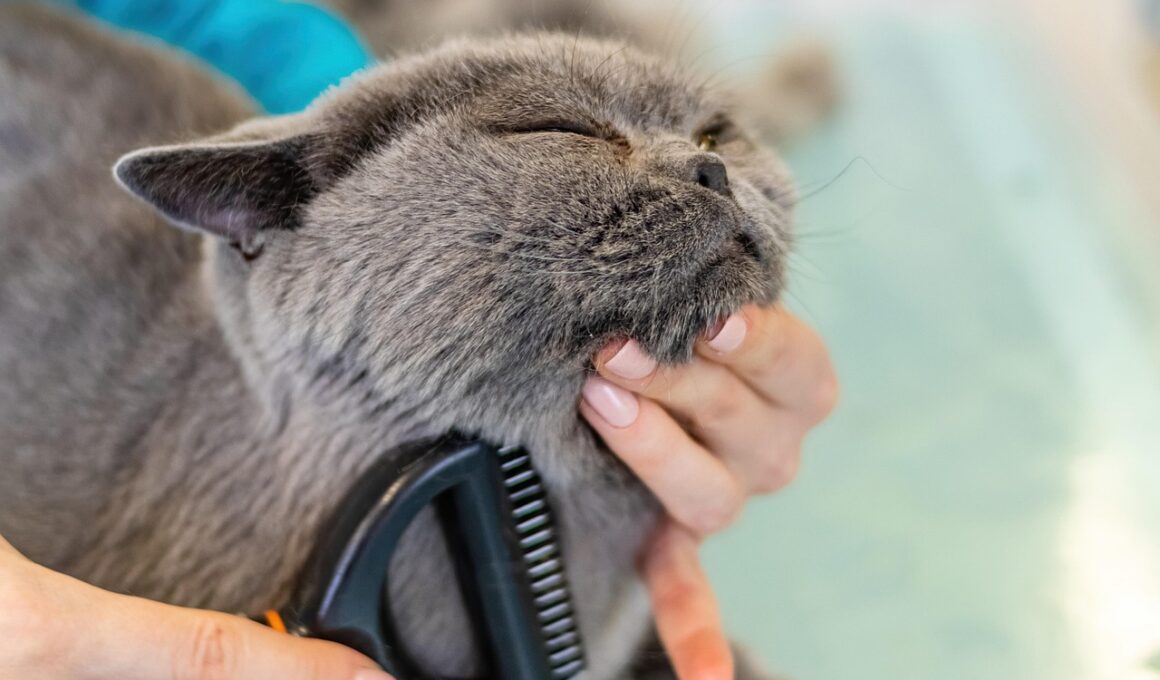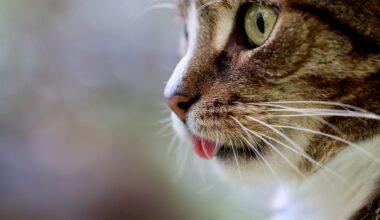Differentiating Between Normal Shedding and Health Concern-Related Fur Loss
Understanding fur loss in cats can be a complex task, particularly distinguishing between normal shedding and hair loss due to health concerns. All cats shed fur, but the amount and frequency can vary notably among individual felines. Normal shedding is influenced by season, age, and even diet. In contrast, when a cat loses an excessive amount of fur, often leading to bare patches, it may indicate underlying health issues. Observing patterns in shedding can provide crucial insights. A sudden increase in shedding or patchy areas might suggest problems such as allergies, parasites, or other health concerns. Pet owners should monitor not only the amount of fur shed but also the condition of the fur and skin. Healthy fur should be smooth, shiny, and free from bald spots. Introducing a grooming routine can help inspect for these signs. This proactive approach allows pet owners to catch potential issues early before they escalate into more severe health problems. So, regular brushing sessions can help maintain a cat’s coat and enable owners to better observe any abnormal changes.
While examining the shedding patterns in your cat, it is essential to assess their overall health and behavior. Unexplained changes in appetite, lethargy, or altered eating habits can accompany fur loss associated with health issues. Allergies, whether food-related or environmental, can trigger excessive shedding in cats. Frequent scratching or biting at the skin may signify an allergic reaction to substances like pollen, dust mites, or specific ingredients in their food. In such cases, it is crucial to consult a veterinarian for appropriate diagnostics and care. Parasites, including fleas and mites, are also common culprits leading to fur loss. Regular dental care and providing a balanced diet are essential to maintain skin health, thus reducing risks of fur loss. Regular check-ups with your vet can help detect allergies or parasites early. These measures contribute to long-term health and wellness. Additionally, it’s vital for cat owners to understand that various factors, including genetics and seasonal changes, can influence shedding. Keeping a close eye on your pet’s shedding patterns allows timely intervention when necessary, ultimately promoting a happier, healthier cat.
Signs of Abnormal Fur Loss
By knowing the signs of abnormal fur loss, pet owners can quickly determine whether their cat needs veterinary care. If your cat is losing hair in circular patches, it may indicate an issue called alopecia, often stemming from hormonal imbalances or fungal infections. Other signs to observe include redness, irritation, or a foul smell on the affected skin. These symptoms can suggest infections or dermatological conditions needing immediate attention. Moreover, if your cat inflicts harm on its coat through excessive grooming or biting, it is essential to identify the underlying cause. Providing mental stimulation, addressing stress factors, and ensuring a soothing environment can significantly reduce such behaviors. Nutritional deficiencies can also contribute to fur loss in cats. Owners must ensure a well-balanced diet rich in essential vitamins and minerals. High-quality feline nutrition plays an indispensable role in maintaining a healthy coat. Research demonstrates the benefits of omega fatty acids in promoting skin and coat health. Consulting a veterinarian about an appropriate diet can alleviate dietary deficiencies that lead to abnormal shedding patterns.
It’s important to note that age can also influence shedding patterns in cats. As cats age, their fur may become thinner due to decreased oil production and hormonal changes. Senior cats may experience different texture changes in their coats, leading to uneven shedding. Regular grooming becomes even more crucial for older cats, helping to keep the fur clean, reducing hairballs, and ensuring skin health. Furthermore, if you notice a notable shift in behavior, such as reluctance to be touched or signs of discomfort while grooming, it warrants further investigation with your veterinarian. Behavioral changes can indicate pain, stress, or underlying medical concerns. Thorough assessments can reveal problems that may otherwise go unnoticed. It is crucial for every cat owner to prioritize routine veterinary check-ups as they age. Frequent assessments will prompt timely intervention, ensuring both overall health visibility and adequate shedding. Always track any noticeable changes in your cat’s appearance, including fur texture and shedding frequency. A keen observation can play a pivotal role in helping address potential health issues before reaching critical stages.
Importance of Regular Grooming
Regular grooming helps manage shedding while allowing you to identify and monitor health concerns. It fosters a bonding experience between you and your cat, creating trust. During grooming sessions, pet owners can examine their cats for signs of health issues. This interaction can facilitate easier vet trips, especially for anxious cats. Furthermore, grooming contributes to your cat having a clean and comfortable coat. Maintaining hygiene through grooming can help reduce the environmental impact of shedding around your home. Excessive shedding can lead to clogged vacuum filters and dander accumulation, which may cause allergy flare-ups for residents. Frequent brushing can, therefore, result in a cleaner living environment for everyone sharing your home. It can also enhance your cat’s appearance, maintaining a healthy and shiny coat. Options for grooming tools are varied, ranging from slicker brushes to de-shedding tools, each serving different coat types. Understanding your cat’s grooming needs is essential. Providing structured grooming routines can have lasting benefits, both for cat and owner. It ultimately accounts for better health management, allowing for early intervention when necessary.
To ensure that your grooming sessions yield positive results, it is crucial to incorporate specific techniques. Start by acclimating your cat to the grooming tools gradually, allowing positive associations to develop. Short sessions can be more effective, as longer grooming may cause stress. Monitor your cat’s reactions during grooming, and if your feline shows signs of discomfort, pause or cease the activity. Offering treats during and after grooming sessions reinforces a positive experience. Additionally, selecting appropriate grooming products specifically formulated for cats is vital. Using the wrong products can lead to allergic reactions and exacerbate shedding issues. It’s advisable to use gentle shampoos and conditioners designed for sensitive feline skin to avoid irritation. Remember that grooming frequency can vary according to your cat’s coat type. Long-haired cats may require daily grooming, while short-haired breeds may thrive on weekly sessions. Also, be mindful of environmental stressors that may heighten shedding, like changes in climate or routine. By maintaining a consistent grooming practice, you not only manage shedding but also care for your cat’s overall well-being.
Conclusion
In conclusion, understanding the nuances between normal fur shedding and health-related fur loss empowers cat owners to provide better care. Through observation of shedding patterns, behavioral changes, and conditions of the fur, pet owners can identify potential health concerns. Regular veterinary visits and grooming routines can significantly aid in early detection of issues while promoting healthy skin and coat. Each cat is unique, and their shedding patterns hinge on various factors, including age, diet, and genetics. Although shedding is a natural part of a cat’s life, excessive or sudden shedding signals potential health complications. Increased awareness of these differences fosters a proactive approach towards feline health care and enriched quality of life. Caring for your cat involves understanding their individual needs and addressing changes promptly before they escalate into serious conditions. Furthermore, maintaining a clean living environment stands to benefit both owners and pets alike. Effectively managing grooming routines can create harmony at home while ensuring your feline remains healthy, vibrant, and happy. Emphasizing proper grooming and monitoring will lead to a fulfilling relationship with your beloved feline companion.
Your cat’s health and well-being are vital, making it essential to be vigilant about their grooming habits.


